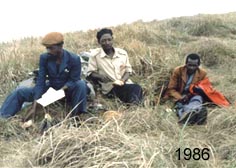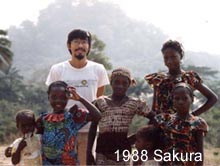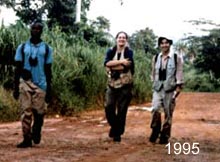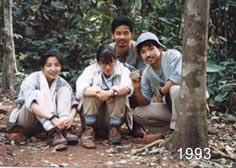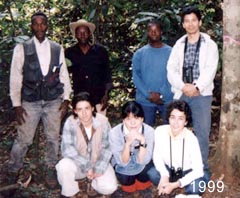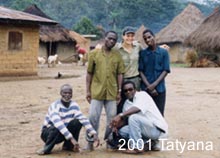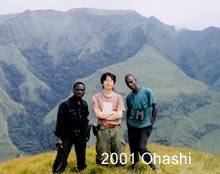HOME » Research History
Research History
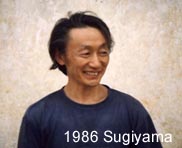
Bossou was originally discovered as an important chimpanzee field site by the French Zoologist M. Lamotte in 1942 (Kortlandt, 1986). Kortlandt visited Bossou briefly several times during the early 60's and was the first primatologist to conduct research on this chimpanzee community (Kortland, 1962).
However, it was not until 1976 that Bossou was established as a long-term field site for the study of chimpanzees (Pan troglodytes verus) by professor Sugiyama from the Kyoto University Primate Research Institute, Japan (Sugiyama and Koman, 1979a, 1979b; Sugiyama, 1981). A detailed research program at Bossou has been implemented by professor Sugiyama since 1976 and then by professor Matsuzawa since 1986 and their respective team of students.
Since its establishment, the running of the Bossou field site has always been under the auspice of the Kyoto University Primate Research Institute, (KUPRI) in Japan. Since 1995, the KUPRI team has welcomed students and researchers from countries outside Japan. Therefore, not all researchers and students currently belong to the Primate Research Institute. "KUPRI", the word used in Guinea, now stands for the international team for the project of scientific research and conservation of chimpanzees in Guinea Forestiére. Every year, several researchers and graduate students visit Bossou and surrounding sites to collect data focused primarily on population dynamics, tool-use, ontogeny and social transmission of behavior, and feeding ecology. Other research areas include social dynamics, reproductive behavior, and vocalizations of the chimpanzees.
Continuation of scientific research at Bossou has been carried out in a close cooperation with the DNRST (Direction Nationale de la Recherch Scientifique). IREB (Institut de Recherche Environnementale de Bossou), an institute under the responsibility of the DNRST, was inaugurated in 2001 by the Guinean government. The creation of IREB has allowed for the establishment of a Guinean research institute which aims to promote biodiversity conservation research at Bossou and the Nimba Mountains in partnership with KUPRI. A scientific convention of collaboration was signed between the DNRST and KUPRI for the first time in 1985. This convention was renewed in 1993 for a 5 year period and then again in 1998 and in 2003 for the same period of duration. Since 1976, a series of Guinean researchers, students and administrators have been involved in the different research projects run at Bossou and Nimba.
Due to the tenacity and the scientific rigor of long-term
research, the Bossou site acquired an international reputation and is
now recognized as one the 6 long-term field sites for the study of chimpanzees
in the wild.
Studies conducted at Bossou have contributed significantly to a better
understanding of the behavior and ecology of wild chimpanzees, in particular
focusing on their ability to make and use tools.
